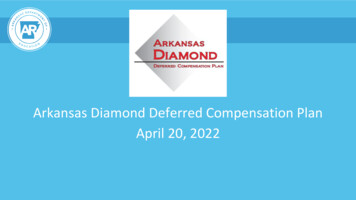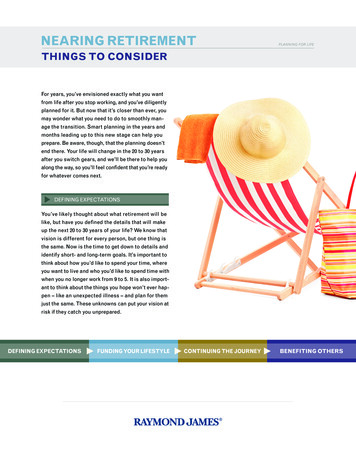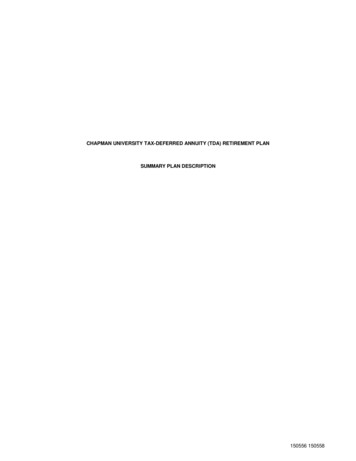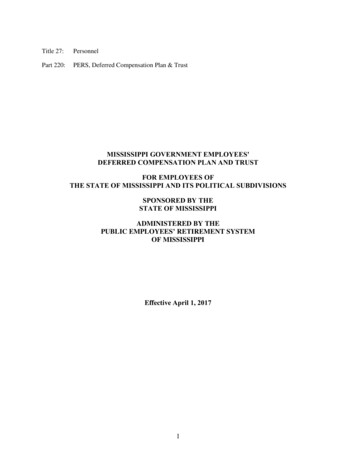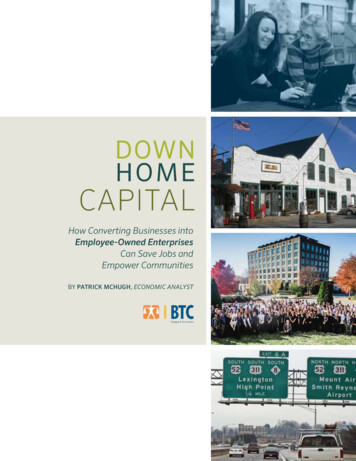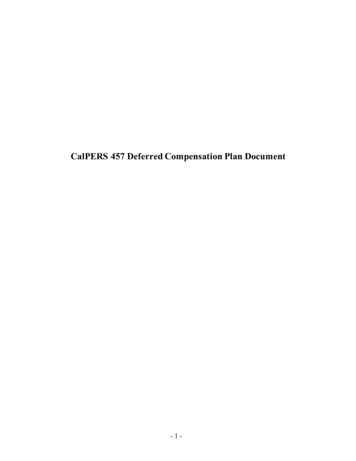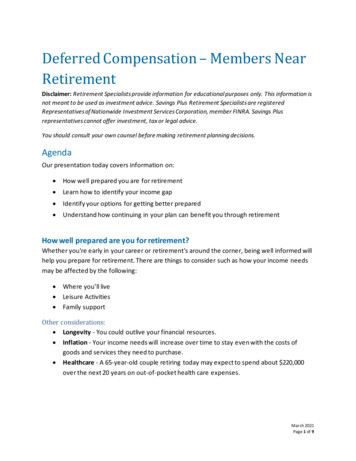
Transcription
Deferred Compensation – Members NearRetirementDisclaimer: Retirement Specialists provide information for educational purposes only. This information isnot meant to be used as investment advice. Savings Plus Retirement Specialists are registeredRepresentatives of Nationwide Investment Services Corporation, member FINRA. Savings Plusrepresentatives cannot offer investment, tax or legal advice.You should consult your own counsel before making retirement planning decisions.AgendaOur presentation today covers information on: How well prepared you are for retirement Learn how to identify your income gap Identify your options for getting better prepared Understand how continuing in your plan can benefit you through retirementHow well prepared are you for retirement?Whether you're early in your career or retirement's around the corner, being well informed willhelp you prepare for retirement. There are things to consider such as how your income needsmay be affected by the following: Where you’ll liveLeisure ActivitiesFamily supportOther considerations: Longevity - You could outlive your financial resources. Inflation - Your income needs will increase over time to stay even with the costs ofgoods and services they need to purchase. Healthcare - A 65-year-old couple retiring today may expect to spend about 220,000over the next 20 years on out-of-pocket health care expenses.March 2021Page 1 of 9
How much will you need in retirement?Most financial experts state you need approximately 75 to 90 percent of your retirementincome. You should check if you have an income gap by determining: The percentage of income you need in retirementThe estimated amount from your pensionHow much is needed from other sourcesHow Much Income Can You Expect?Three potential income resources:CalPERS Visit the CalPERS website and select Retirement Estimate Calculator to run severalestimates, keep in mind that these are just estimates.Log in your myCalPERS account and select the Education tab to enroll in a Planning YourRetirement classContact us at 888-CalPERS (or (888) 225-7377)Social Security Visit the Social Security Administration (SSA) website and select the RetirementEstimator which gives you a benefit amount based on your actual Social Securityearnings record. Reminder these are just estimates.Contact Social Security at (800) 772-1213Contact your previous employers to: Gather information on previous 401(k), 457(b), or 403(b) plansEvaluate the options that may be available to youLearn How to Identify Your Income GapAs you run estimates and contact your previous employers to gather all your information andyou notice the possibility of an income shortage, you can: Work longerWork in retirementIncrease your savingsSave as much as you can through your planThere are contribution limits, check with your plan for more detailed information.March 2021Page 2 of 9
Understand How Continuing in Your Plan Can Benefit You Through RetirementSave more through your plan by: Maximizing your deferred compensation contributionsTaking advantage of catch-up opportunitiesTransferring unused leave time at separation (if applicable)Combining outside assets – IRAs, 401(k), 403(b), and 457(b) – with your currentemployer accountRollover Other Assets Personal help now and through retirementProfessionals research and monitor fundsOne investing strategy to manageOne payout strategy to manageOne set of feesNOTE: There are generally several considerations relevant to evaluating whether you might rollover outside assetsor leave the money where it is currently invested. Qualified retirement plans, deferred compensation plans andindividual retirement accounts are all different, including fees and when you can access funds. Assets rolled overfrom your account(s) may be subject to surrender charges, other fees and/or a 10% early withdrawal tax ifwithdrawn before age 59½. It’s important to understand retirement account differences and similarities, such asfees, services, investment options, etc., before making any rollover decisions.I think it would be good to include info about the limits, Catch-up and Age-based catch-up – just not the specific amounts.Flexible payout options.Withdrawals are an important element of your account to understand. You can take out smallor large sums anytime, or you can set up automatic, periodic payments.If your plan allows it, you may be able to have direct deposit which allows for fast transfer offunds. Unlike a check, direct deposit typically doesn’t include a hold on the funds from youraccount.Keep in mind that taxes are due on any amount you withdraw, not the balance in yourretirement funds account.When Can You Take Payouts Without Penalty?The rules for distributions differ between 401(k) and 457(b) plan types. Under IRS rules:401(k) Participants must be at least 55 and retired, or over 59½. In addition, if you suffer ahardship as defined by the IRS and Savings Plus policy, your 401(k) account will have income taximplications.457(b) Assets can be withdrawn without penalty at any age upon separation from service fromthe plan sponsor, or age 70½ if still working. In addition, if you suffer an unforeseeableMarch 2021Page 3 of 9
emergency as defined by the IRS and your plan’s policy, there is no tax penalty for this earlywithdrawal unless your 457(b) account contains amounts received by a rollover deferral from asource other than another 457(b) plan.Required Minimum Distribution (RMD)You cannot keep retirement funds in your account indefinitely. You generally have to start takingwithdrawals from your IRA, SIMPLE IRA, SEP IRA, or retirement plan account when you reachage 72 (70 ½ if you reach 70 ½ before January 1, 2020).Check with your plan to find out how this will work for you.Your required minimum distribution is the minimum amount you must withdraw from youraccount each year. You can withdraw more than the minimum required amountYour withdrawals will be included in your taxable income except for any part that wastaxed before (your basis) or that can be received tax-free (such as qualified distributionsfrom designated Roth accounts)If you retire or separate and you’re age 72 or older, you must take your RMD in the year inwhich you retire or separate.If you don't take withdrawals, or you take less than you should: You'll owe a 50 percent federal penalty tax on the difference between the amount youwithdrew and the amount you should have withdrawnYou’ll still have to withdraw the required amount and pay any income tax due.Visit the IRS website for more detailed information on RMDs.March 2021Page 4 of 9
What are the payout withholdings?All withdrawals are taxed as Ordinary Income. The amount of federal income tax that iswithheld depends on which benefit payment option you select: Mandatory Tax Withheld - A mandatory 20 percent federal income tax is withheld onfull and partial withdrawal, and periodic payments completed in less than 10 years(except when it is an RMD).Periodic Payments - made over more than 10 years – federal taxation is determined byyou, the participant. If less than 10 years, the 20 percent federal taxation applies.RMD and Emergencies - are subject to a 10 percent federal income tax withholding.o NOTE: “Subject to” means that the tax withholding is not mandatory and can beadjusted to either a higher or lower amount.After the close of the year, an IRS 1099R form will be sent to you for tax reporting. On the form,it will report: Your total withdrawal amount for the yearThe amount of federal taxes withheldThe amount of state taxes withheld (if any)What else should you consider during your retirement checklist? Check your beneficiaries at least annually and update when appropriate Update your mailing address every time it changes Read any newsletters from your plan Review your statements Monitor how your account compares to your investor profile Review your investment electionsInvesting helpful tips: It’s never too early and never too late Start with a comfortable amount and make changes as you go If you received a raise recently – don’t adjust your lifestyle to your raise, save the extraincome Remember, no action is also an actionMarch 2021Page 5 of 9
Deferred CompensationSavings Plus ProgramThe Savings Plus is a program that provides 401(k) and 457deferred compensation plans forState of California and California State University employees. You can choose to contribute bypayroll deduction on a tax-deferred or tax-free Roth basis. Savings Plus is administered by theCalifornia Department of Human Resources (CalHR).Benefits: Tax-deferred contributions allow you to defer paying taxes on your contributions and anyearnings until you withdraw your assets, generally during retirement. Roth contributions comes out of your pay after taxes are deducted and generally will notreduce your current tax liability.A note about 401(k) and 457(b) Plan Roth distributions: if you meet any of the following criteria,you can receive payment from your 401(k) Plan without an additional 10 percent tax for earlywithdrawal:1. Separated from state service during or after the year you turned age 55; or2. Separated from state service during or after the year you turned age 50 if you are apublic safety employee; or3. Attainment of age 59½, regardless of your employment status.A note about 401(k) and 457(b) Plan Roth distributions: a Roth distribution will be tax free if thedistribution is made 5 years or more after January 1 of the calendar year in which the first Rothcontribution or Roth conversion was made and the distribution was made on account of death,disability, or attainment of age 59½.CalPERS 457 PlansThe CalPERS 457 Plan is for employees of participating public agencies and schools. Allemployees whose employers have adopted the CalPERS 457 Plan are eligible to join the plan,and there are currently no minimum service requirements to fulfill.Benefits: The plan is a voluntary savings program that allows you to defer any amount, subject toannual limits, from your paycheck on a pretax basis.Your contributions and your earnings, if any, can benefit from the power of tax-deferredcompounding.o This means you don't pay income taxes on your contributions or earnings untilyou start taking withdrawals, which is usually in retirement.To enroll, your employer must participate in the plan.March 2021Page 6 of 9
CalPERS Supplement Contributions PlanThe CalPERS Supplemental Contributions Plan (SCP) is an after-tax supplemental contributionplan available to state employees and members of the Judges' Retirement Systems I and II.Additionally, as directed by statute, the SCP serves the default rollover account for POFFparticipants that didn't make an affirmative election during the POFF termination.Benefits: You may make periodic cash contributions or after-tax payroll deductions. You maychange your contribution amount and allocation, and transfer account balances amonga variety of investment options.SCP allows you to voluntarily invest after-tax contributions into an account where allearnings grow tax deferred until you begin to take withdrawals in retirement or uponseparation from all state employment. You’ll only pay taxes on the earnings.Upon distribution, you only pay taxes on the earnings.Reminder: You should consult your own counsel before making retirement plan decisions.Contact InformationContact your plan provider or personnel office for more information on your employer’s 401(k) 457(b), or 403(b) planPublic agency and school employees with the CalPERS 457 Plan, contact CalPERS 457 Plan Monday through Friday 6:00 a.m. - 5:00 p.m. PT Call (888) 713-8244State of California employees, contact Savings Plus Solutions Center Monday through Friday 5 a.m. - 8 p.m. PT Call (855) 616-4776State of California employees and members of the Judges' Retirement Systems I and II, contact CalPERS Supplement Contributions Plan Monday through Friday 6:00 a.m. - 5:00 p.m. PT Call (800) 260-0659.March 2021Page 7 of 9
Glossary of TermsAsset Allocation – The strategy of spreading investment funds across asset classes, such as cashand fixed income, bonds, and stocks, to help minimize risk. The process of determining whichmix of assets to hold in your portfolio is a very personal one.Keep in mind, the use of asset allocation does not guarantee returns or protect from potentiallosses.Asset Rebalancing – An investing strategy through which a participant periodically exchanges ormoves between funds in their account, in an effort to maintain a specific investment mixdesignated.Diversification – Portfolio strategy designed to spread risk by allocating assets among a varietyof investments, such as short-term investments, bonds and stocks.Rebalancing – A strategy to sell investments that have been performing well and invest moreinto those that have fallen behind – a buy low, sell high approach. Your financial professional ortax adviser can help you identify ways that you can minimize these potential costs.Risk Tolerance - Is your ability and willingness to lose some or all of your original investment inexchange for greater potential returns.Risk versus Reward - When it comes to investing, risk and reward are inextricably entwined. Allinvestments involve some degree of risk. If you intend to purchase securities - such as stocks,bonds, or mutual funds - it’s important that you understand before you invest.Time Horizon - The expected number of months, years, or decades you will be investing toachieve a particular financial goal to begin to take distributions from your retirement plan.Disclaimer: This material is not a recommendation to buy, sell, hold or roll over any asset, adopt aninvestment strategy, retain a specific investment manager or use a particular account type. It does nottake into account the specific investment objectives, tax and financial condition or particular needs ofany specific person. Investors should work with their financial professional to discuss their specificsituation.March 2021Page 8 of 9
Additional resources include: Register for our monthly webinarsWatch our YouTube VideosCustomer Contact Center 888 CalPERS (or 888-225-7377)Follow us on Social MediaMarch 2021Page 9 of 9
Deferred Compensation Savings Plus Program The Savings Plus is a program that provides 401(k) and 457deferred compensation plans for State of California and California State University employees. You can choose to contri bute by payroll deduction on a tax-deferred or tax-free Roth basis. Savings Plus is administered by the
